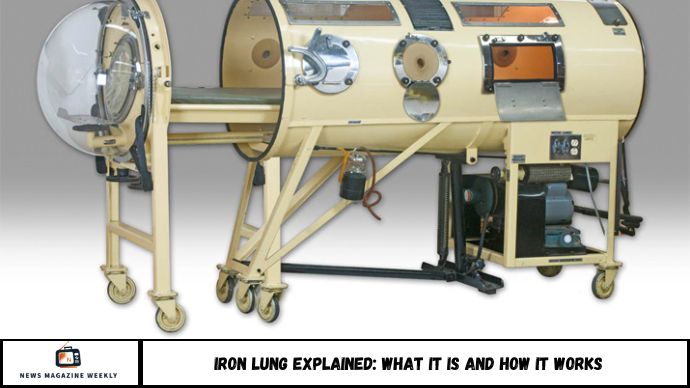An iron lung is a mechanical respirator that helped thousands of people survive polio-induced paralysis in the 20th century. This article explains how the device works, its history, its impact on medical innovation, and why it’s still remembered today as one of the most iconic machines in healthcare.
The iron lung—also known as the negative pressure ventilator, cabinet respirator, or tank respirator—may sound like something from a horror movie, but for many, it was a lifesaver. Developed nearly a century ago, this groundbreaking device became synonymous with life-saving technology during the polio epidemics of the 20th century.
Before the polio vaccine became available in 1955, this virus was a silent killer, paralyzing muscles and leaving thousands unable to breathe. Polio sufferers, particularly children, faced a terrifying reality: paralysis that could stop them from breathing. The iron lung was the miracle machine that kept them alive long enough for their muscles to recover.
But what exactly is an iron lung, and how did it help people breathe when their bodies couldn’t? Let’s dive into the history and mechanics behind this iconic medical device.
The Rise of the Iron Lung: A Medical Breakthrough in a Crisis
Imagine being paralyzed overnight, unable to breathe on your own. That was the terrifying reality for thousands during the polio epidemics of the early 1900s. With no cure in sight, doctors turned to an unlikely savior: a massive metal machine called the iron lung.
First developed in 1928 by Philip Drinker and Louis Shaw, the iron lung offered a revolutionary way to mechanically support breathing—especially for polio patients who had lost control of their diaphragm and chest muscles.
But how exactly did this machine keep people alive—and why is it still talked about today?
What Is an Iron Lung?
The iron lung (also known as a negative pressure ventilator) is a large, cylindrical chamber that encloses a patient’s body, leaving only the head exposed. It was used to help people breathe when their muscles couldn’t—usually due to neurological conditions like poliomyelitis.
Unlike modern ventilators, which use positive pressure to push air into the lungs, the iron lung worked by creating negative pressure around the chest, simulating natural breathing.
How Does an Iron Lung Work?
1. Creating Negative Pressure
The machine alternately reduced and increased the air pressure inside the chamber:
- Pressure drops → The chest expands, air is pulled into the lungs (inhalation).
- Pressure increases → The chest compresses, pushing air out (exhalation).
This mimicked the natural mechanics of breathing.
2. Continuous Operation
The process repeated 12–20 times per minute, often running 24/7 for weeks, months, or even years, keeping the patient alive.
Why Was the Iron Lung So Important?
During the height of the polio epidemic in the 1940s and 1950s, thousands of children and adults were placed in iron lungs. For many, it was the only way to survive the paralysis of respiratory muscles caused by the virus.
Key Contributions:
- Saved tens of thousands of lives worldwide
- Laid the foundation for modern ventilator design
- Sparked new approaches to intensive care
The Decline of the Iron Lung
With the introduction of the polio vaccine in 1955, the need for iron lungs sharply declined. By the 1970s, most hospitals had replaced them with smaller, more efficient ventilators.
Today, very few iron lungs remain in use—though some individuals (notably Paul Alexander, known as “the man in the iron lung”) have lived inside them for decades.
The Legacy of the Iron Lung
Though nearly obsolete, the iron lung remains a symbol of resilience, innovation, and medical history. It represents an era when medicine raced against time to keep patients alive—and succeeded against the odds.
Its legacy is also seen in how we approach respiratory care, including during modern crises like COVID-19, which highlighted the ongoing need for effective ventilatory support.
FAQs
1. Who invented the iron lung?
It was invented in 1928 by Philip Drinker and Louis Shaw at Harvard University.
2. What disease was the iron lung used for?
Primarily for poliomyelitis, which could paralyze the muscles needed for breathing.
3. How long did people live in iron lungs?
Some stayed for weeks or months; a few, like Paul Alexander, have lived in them for over 70 years.
4. Are iron lungs still used today?
They’re extremely rare but still in use by a handful of individuals. Most modern cases use advanced ventilators.
5. What replaced the iron lung?
Positive pressure mechanical ventilators, which are more compact and efficient.
6. Can the iron lung be used for COVID-19?
Theoretically yes, but modern ventilators are far more effective and practical for today’s needs.
Conclusion
The iron lung may look like a relic, but it represents a time when ingenuity and necessity gave rise to life-saving technology. Its role in the fight against polio helped shape the evolution of modern medicine, from intensive care units to mechanical ventilators.
Understanding how the iron lung worked not only gives us insight into the past—it reminds us of how far we’ve come and the critical role technology plays in saving lives today.

